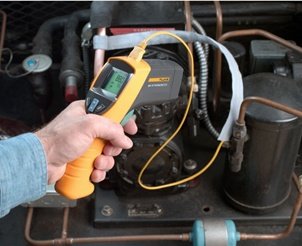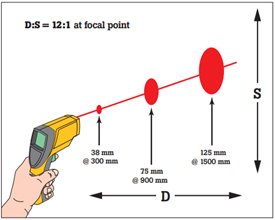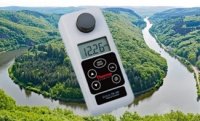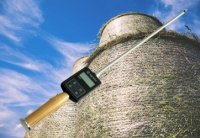Product Review: HVAC PRO IR Thermometer (IC-FLUKE-561)

The Instrument Choice Team of Scientists regularly reviews new and popular products, so when searching for the perfect scientific instrument for your application, you can make more informed decisions.
This edition reviews the ever-popular HVAC PRO IR Thermometer (IC-FLUKE-561). The Fluke 561 Thermometer is a dual function IR and contact thermometer built into one ergonomic, portable and easy-to-use package.
Advantages of a Contact and Non-Contact Thermometer
Benefits of Contact Thermometers
Contact Thermometers are generally more accurate than Infrared Thermometers as they touch the surface in question to take a reading.
Benefits of Infrared Thermometers
Infrared Thermometers are useful for any application where an object’s surface area needs to be determined rapidly and where touching the surface is bad practice, unsafe, or impossible. They are perfect for measuring such objects as:
- Moving objects or surfaces
- Hot surfaces
- Hard to reach places; and
- Sterile and cleanroom environments.
The Fluke 561 Thermometer
The Fluke 561 thermometer brings together the best of both worlds. It incorporates an IR thermometer and an input for standard mini-connector type K thermocouples that enable contact measurements. This all-in-one tool eliminates the inconvenience of multiple temperature testing tools. Performing measurements is efficient, reliable and accurate.
Summary Features and Benefits of the Fluke 561 Infrared Thermometer
- Distance to spot ratio: The distance to spot size of 12:1 allows users to scan large areas or measure small objects up close.
- Laser Spot: The single spot laser sighting on the IR thermometer helps users aim and know their measurement's centre point.
- Adjustable Emissivity: Straightforward emissivity adjustment means enhanced accuracy when measuring pipes and other shiny materials. Adjustable with three settings: low (0.3), medium (0.7). high (0.95).
- Contact Measurement: The Fluke 561 thermometer is compatible with all standard mini-connector type K thermocouples.
- Wide Temperature Range: The impressive temperature range of -40°C to 550°C covers most industrial applications.
- Temperature Functions: Supplementary temperature information such as MIN, MAX, AVG and DIF can be viewed, helping you to identify problems rapidly.
- Display: The backlit LCD interface is easy to navigate. Users can easily view temperature readings, the low battery status, °C/°F indicator, and scan/hold function icons.
- Lightweight: The Fluke 561 thermometer weighs only 340 grams, ensuring it is highly portable.
- Mounting Options: A convenient built-in tripod thread makes the thermometer straightforward to deploy.

Figure 1 Distance to spot ratio of 12:1 for the Fluke 561 thermometer
Fluke 561 Thermometer Specifications
Fluke 561 Thermometer – IR Thermometer Specifications |
|
|
Temperature Range |
-40°C to 550°C |
|
Accuracy |
<0°C: ±(1.0°C + 0.1°C/1°C) >0°C: ±1 % or ± 1.0°C, whichever is greater |
|
Repeatability |
± 0.5 % of reading or ± 1 °C, whichever is greater |
|
Display Resolution |
0.1°C of reading |
|
Spectral Response |
8 µm to 14 µm |
|
Response Time |
500mSec (95 % of reading) |
|
Distance to Spot Ratio |
12:1 |
|
Emissivity |
Adjustable with three settings: low (0.3), medium (0.7). high (0.95) |
|
Laser Power |
Class 2 (II) operation; output <1mW, wavelength 630nm to 670nm |
Fluke 561 Thermometer – Contact Thermometer Specifications |
|
|
K-Type Thermocouple Input Temperature Range |
0°C to 100°C |
|
K-Type Thermocouple Input Accuracy |
Input accuracy ±2.2°C |
|
K-Type Thermocouple Resolution |
0.1°C |
|
Included K-Type Thermocouple Probe (Wrap Type) - Cable Length |
505 mm cable terminated with a Type K thermocouple inside a 495 mm nylon cuff |
Fluke 561 Thermometer – Other Specifications |
|
|
Operating Temperature |
0°C to 50°C |
|
Weight |
0.322 kg |
|
Dimensions |
17.69 cm x 16.36 cm x 5.18 cm |
|
Power |
2 AA /LR6 Batteries (alkaline or NiCD) |
|
Battery Life |
12 hours with laser and backlight on; 100 hours with laser and backlight off, at 100 % duty cycle (thermometer continuously on) |
Fluke 561 Thermometer Applications
Where could you use the Fluke 561 thermometer? Anywhere! Check out the list below for a few examples of ideal applications;
- HVAC: Assessing duct leakage, supply/return register, liquid flow through pipes, blower motors, air balance/stratification, superheat and sub-cooling and valves and steam traps.
- Electrical: Measuring electrical panels, wiring, cables, ballasts, bus bars, outlet boxes, motors or oil-filled transformers.
- Maintenance and process applications: Control control checks, machine condition monitoring, oven insulation checking and finished product temperature confirmation.
- Mechanical: Checking hydraulics, gears, shaft alignment, bearings or motor cases.
- Automotive: Evaluating engine cooling systems, cylinder misfires, heating/cooling systems, brakes, bearings, motors, catalytic converters and hydraulic systems.
Conclusion
The Fluke 561 is a no-compromise solution when you can’t choose between a contact or non-contact IR thermometer and need to measure extremes in temperature.
Our scientists' final verdict of the Fluke 561 Thermometer?
“The ideal multi-application measurement tool for anyone in the HVAC, Electrical, Maintenance or Automotive industries. A must-have for any toolbox!”
Want more information about the Fluke 561 Thermometer? Speak with an Instrument Choice Scientist! We’re here to help! Call 1300 737 871 or email [email protected].

Also interesting
The Instrument Choice Team of Scientists regularly reviews new and popular products, so when searching for the perfect scientific instrument for your application, you can make more informed decisions.
This edition assesses the EC-TN100-IR NTU Turbidimeter, a practical, popular and affordable turbidity meter suitable for an extensive range of water quality monitoring applications.
Read on a scientists’ review of the EC-TN100-IR NTU Turbidimeter

The consequences of harvesting, baling and storing hay with incorrect moisture levels are many and costly! Monitoring the moisture content of hay with a hay moisture tester is a quick and easy way to help prevent crop, revenue, and property loss.
There are different methods for measuring moisture with a hay moisture tester, so your Instrument Choice Scientists decided to check out the best methods. Here’s what they found.
Read on for the best ways to manage forage moisture content to create a safe, stable, and valuable product.

